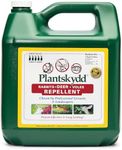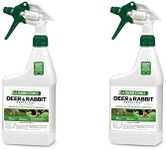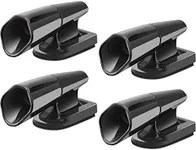Buying Guide for the Best Deer Repellents
Choosing the right deer repellent can be crucial for protecting your garden or property from deer damage. Deer repellents come in various forms and formulations, and selecting the best one for your needs involves understanding the key specifications and how they align with your specific situation. Here’s a guide to help you navigate through the important aspects of deer repellents and make an informed decision.Type of RepellentDeer repellents come in different types, including sprays, granules, and electronic devices. Sprays are liquid solutions that can be applied directly to plants and surfaces, making them ideal for immediate protection. Granules are spread around the area and provide longer-lasting protection, suitable for larger areas. Electronic devices emit sounds or lights to scare deer away and are great for continuous, maintenance-free protection. Choose the type based on the size of the area you need to protect and how often you can reapply the repellent.
Active IngredientsThe effectiveness of a deer repellent largely depends on its active ingredients. Common ingredients include putrescent egg solids, garlic, and capsaicin, which deter deer through taste and smell. Some repellents use predator urine to create a fear response. Understanding the active ingredients helps you choose a repellent that is safe for your plants and pets while being effective against deer. If you have a sensitive garden, opt for natural ingredients. For more persistent deer problems, stronger chemical formulations might be necessary.
Application FrequencyHow often you need to reapply the repellent is an important consideration. Some repellents need to be reapplied after rain or every few weeks, while others can last for months. Frequent application can be labor-intensive but may provide more consistent protection. Long-lasting repellents are more convenient but may be less effective in areas with heavy deer traffic. Consider your availability and the level of deer activity in your area when choosing a repellent with the right application frequency.
Coverage AreaThe coverage area indicates how much space a repellent can protect. This is usually measured in square feet or acres. For small gardens or specific plants, a repellent with a smaller coverage area might be sufficient. For larger properties, look for products that offer extensive coverage to ensure all areas are protected. Assess the size of the area you need to protect and choose a repellent that matches or exceeds this coverage.
Weather ResistanceWeather resistance is crucial for outdoor repellents, as rain and wind can reduce their effectiveness. Some repellents are designed to withstand various weather conditions, ensuring they remain effective for longer periods. If you live in an area with frequent rain or harsh weather, opt for a repellent that is specifically labeled as weather-resistant. This will save you time and effort in reapplying the product frequently.
SafetySafety is a key consideration, especially if you have pets, children, or edible plants in your garden. Some repellents are made with non-toxic, natural ingredients that are safe for humans and animals. Others may contain chemicals that require careful handling and application. Always check the safety information on the product label and choose a repellent that aligns with your safety requirements. If in doubt, natural and organic repellents are generally safer options.













